On Saturday evening, Getafé welcomed the defending champions FC Barcelona to their home stadium Coliseum Alfonso Pérez. The home side have had a very average start to the season, only securing one win and four draws in the first seven La Liga matches. Playing against a side who they haven’t been at the victory end for a while, there were doubts that José Bordalás’s side would turn things around this time.
Meanwhile, Barcelona haven’t had the best start to the season as they would have hoped. Losing points against sides such as Osasuna or Granada made their journey of defending the title more difficult during the first stage. Still, they were able to secure all three points at the end of the day through two goals by Luis Suárez and Juníor Firpo.
This tactical analysis will provide an analysis of Barcelona’s 2-0 win over Getafé. Meanwhile, using statistics, we will identify the key points that helped Ernesto Valverde’s tactics secure a comfortable win over José Bordalás’ tactics.
Lineups
Getafé approached this match with their usual 4-4-2 formation and made one change to the side that drew against Valencia. Centre-back Leandro Cabrera was rested after their trip to the Mestalla, with former Villarreal defender Bruno González stepped into his place. The home side were again without the service of Amath Ndiaye and Vitorino Antunes as they were still recovering from their injuries.
While Jorge Molina was paired up alongside Jaime Mata as the two strikers the last time they were out, Bordalás this time opted for a change as Ángel Rodríguez filled in Molina’s position. Although winger Marc Cucurella was loaned from Barcelona, no clause prevented him from playing against his parent club. Therefore, he became the first choice on the left-hand side as he provided width alongside wing-back Allan Nyom.
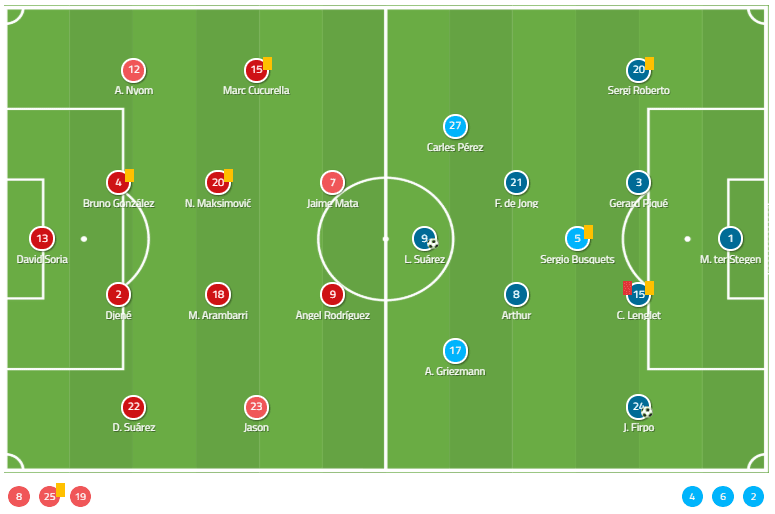
For Barcelona, they lined up in their familiar 4-1-2-3 formation with Gerard Piqué and Clément Lenglet paired up as two centre-backs. Although winger Ousmane Dembélé made his recovery from a hamstring problem against Villarreal, he wasn’t registered for the match and was forced to watch the game from the stands.
Another key player who also missed out was Lionel Messi as his likeliness of featuring in this match wasn’t so high before the team’s trip to Getafé. Problems with foot and hamstring injuries also kept Samuel Umtiti and Jordi Alba on the sidelines respectively. Therefore, Júnior Firpo was chosen to fill in the Spanish left-back’s position eventually.
Getafé’s style of play
After gaining success with Getafé last season, it’s no surprise to see Bordalás continue to employ similar principles to their tactics this season. One of the most noticeable tactical points from their style was forming a tight defensive juggernaut when out of possession. The players were required to be disciplined and stuck to the shape during most of the times as this would limit the space that Barcelona could capitalise.
They were happy to let the visitors have more of the ball inside the middle third of the pitch but would also engage the press when needed. Nonetheless, their main aim was to prevent Barcelona from progressing the ball into the final third and result in a dangerous attack.
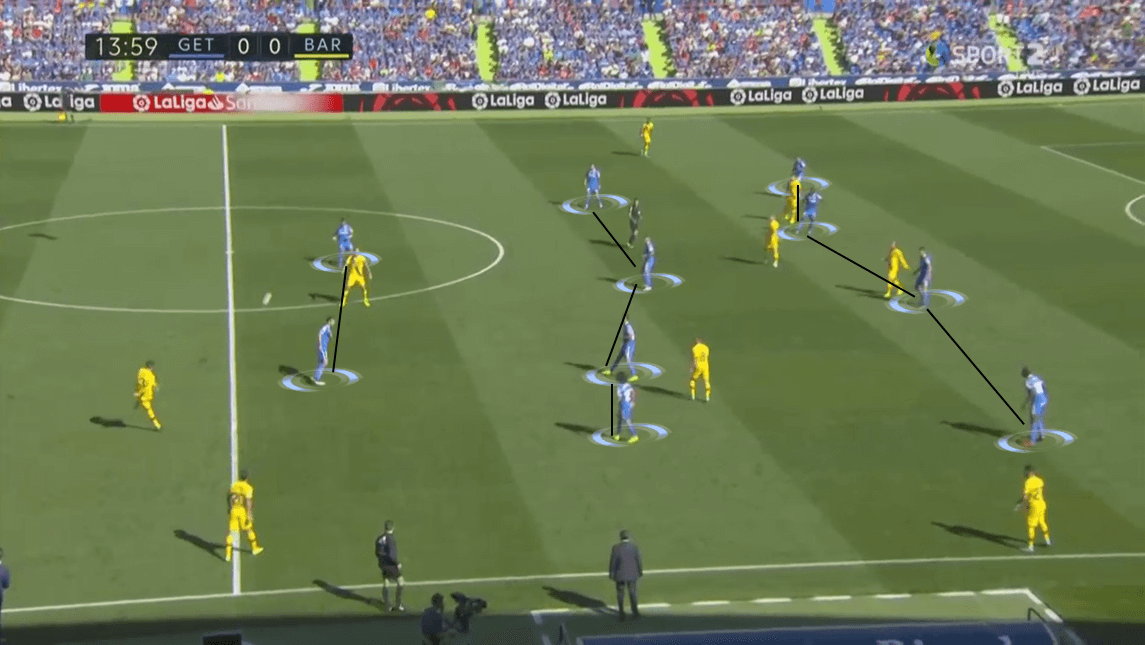
Usually, they would push their defensive line high up the pitch and combine with the midfielders to narrow the gap between the lines. As Barcelona had players who were capable of moving into that space and make the most out of it, Getafé didn’t want them to have space and time to execute and continue the attack.
This strategy was also employed along with an offside trap. Four defenders must be able to time their runs to either move out of their position to tackle the ball or drop deep to cover for their teammates. If they failed to do so, then the likes of Griezmann or Suárez would be able to attack the space behind the defensive line.
In fact, one of those situations had led to the opening goal of the game. Suárez had the tendency of positioning himself on the shoulders of defenders as it allowed him to be at the end of through passes or long balls. In the shot below, he did something similar by being in between Bruno and Djené Dakonam but also kept himself onside. While ter Stegen moved out of the box to intercept the Tologese’s pass, he noticed Suárez’s positioning and used a long pass to find his run.
Using his pace, he sprinted toward the box and also received the pass while beating his marker, Bruno, at the same time. With goalkeeper David Soria opting to move up and attempt a sweep, the Uruguayan striker lobbed him and both Soria and Bruno didn’t stand a chance of stopping the shot. Leaving a huge gap behind the defensive line was possibly the most concerning thing for Getafé in this goal as Suárez had both time and space to make a precise shot. Furthermore, they only used one player to apply pressure on Suárez, which was Bruno, while Djené could also have chased him and provide support for his colleague.
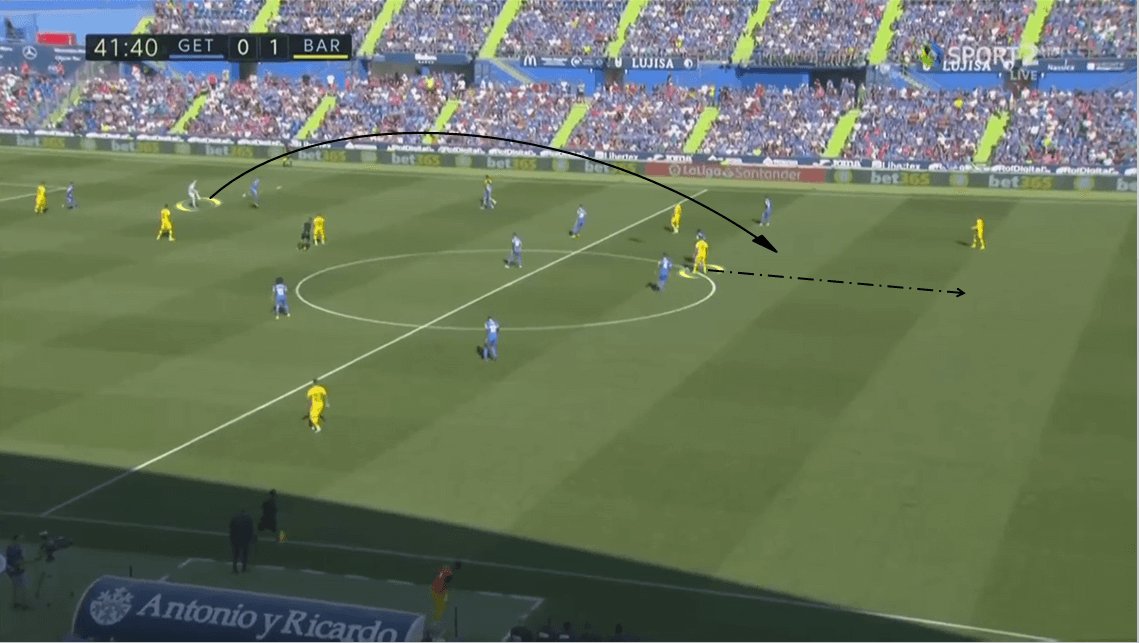
It was not the first and only time that Barcelona capitalised on that error to create chances. While the situation above showed how they made the most out of that area, the shot below shows you how they created it.
Through the flexible movement of winger Carles Pérez, he dropped deep from his position to receive the ball from Sergi Roberto. At the same time, he dragged along Nyom and even Roberto’s marker, Cucurella. This led to the consequence of space being created behind Nyom’s back to allow Barcelona’s right-back to move in.
Also, with Cucurella shifting his attention towards Pérez, Roberto was now free to continue his run and could even call for support from Suárez from the central space. Even if Bruno and Mauro Arambarri managed to reach them, they would only create a 2 v 2 situation inside the mentioned space that would be beaten by the technical abilities of the Barcelona players.
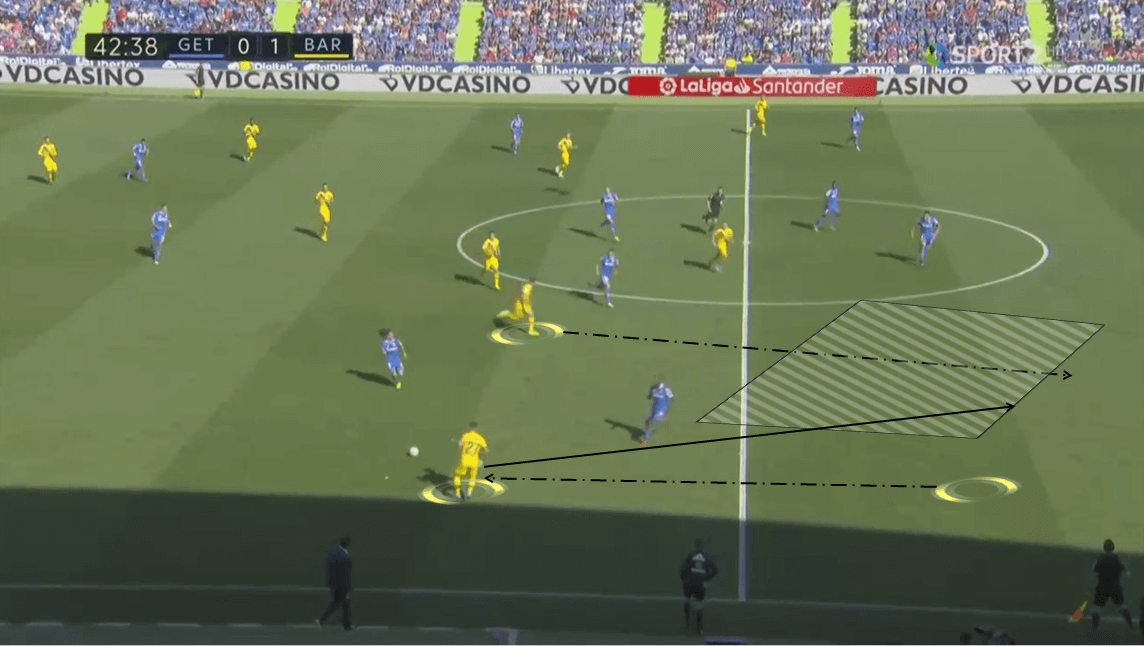
At the other end, though, things looked to be quite positive for them. With a clear man-oriented press and an aggressive attitude when it came to winning the ball, they were able to disrupt Barcelona’s build-up on several occasions. To employ the strategy, the midfield line would push high up the pitch and join the press along with the two strikers.
Usually, Ángel and Mata followed the centre-backs and stuck to them until the build-up process ended. They aimed to nick the ball away from them for a quick counter-attack and eliminated the nearest passing option to them. Meanwhile, four midfielders took on the responsibility of marking the wing-backs and Barcelona’s central midfielders who dropped deep and offered passing options.
But with the fact that the visitors always had a spare man during the process, they could circulate the ball at a high-efficiency rate. Sergio Busquets occupied the role of a half-back, who constantly dropped deep and formed a back three during the build-up to help bring the ball out of defence. He acted as a spare man by moving flexibly in between Barcelona’s defenders and depended on Getafé’s press to position himself.
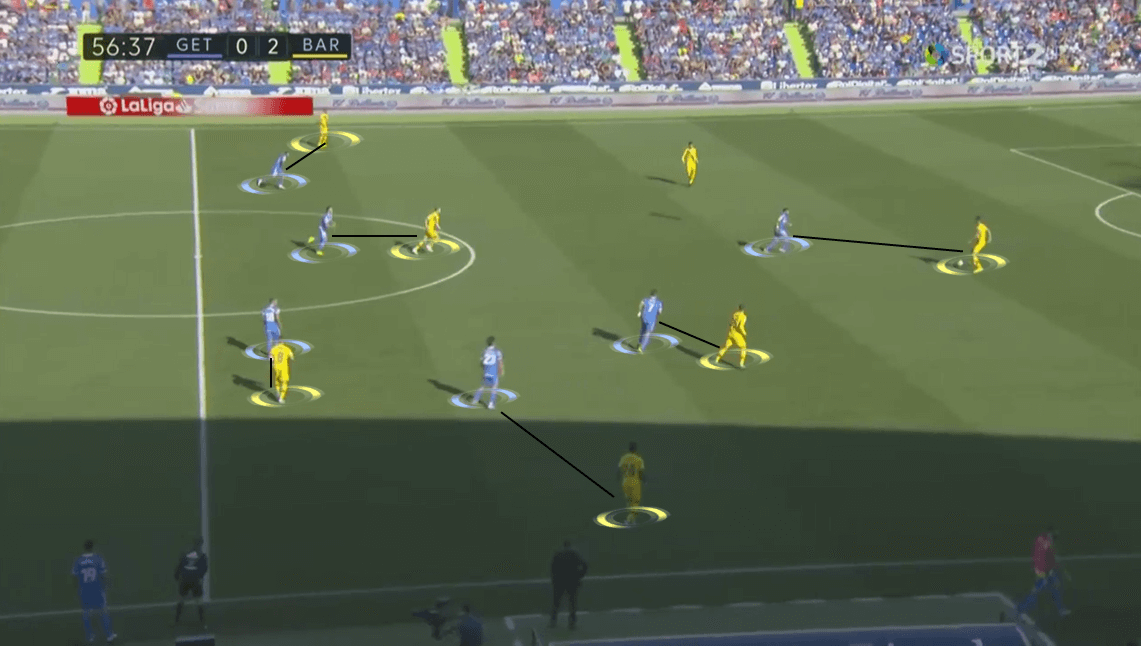
In terms of creating chances, they also proved to be quite efficient in threatening ter Stegen’s goal. In total, they had five out of eight chances which were rated higher than 0.1. Moreover, with most of their chances taking place inside the box, it showed their ability to progress the ball into the 16-yard box and creating chances there.
But, while they remained decent in creating opportunities towards the goal, converting it was something else. Half of the chances that they had were blocked, with only Ángel’s attempt at the 21st minute finding the target. Unfortunately, the former Real Zaragoza player’s shot wasn’t enough to beat ter Stegen.
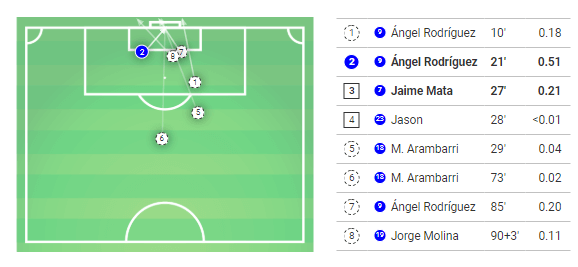
On a day that they created many high-quality chances, Getafé deserved to come away with something. As their total xG rating stood at 1.08, the home side would have had a goal to their name. Still, with luck not on their side and playing against an excellent defensive structure like Barcelona’s, they had no choice but to bow out with no consolation goal.
Barcelona’s style of play
Being the superior team in the match, it’s no surprise to see Barcelona attempt to control more of the ball possession when they entered the match. As mentioned before, using Busquets’ deep positioning, they created a classic Lavolpiana (three-man) build-up inside the central half of the pitch. Along with Piqué and Lenglet, these three would circulate the ball until they found a viable option up front to lay the ball toward.
At times, both wing-backs had the option of staying in their positions and get involved in the build-up. By positioning themselves out wide, they would stretch Getafé’s press and were also able to receive the ball in a free state. Meanwhile, the three attackers up front moved into space in between the home side’s defensive lines. They sat on the shoulder of defenders and would be ready to receive a penetrative pass from the defenders to start an attack.
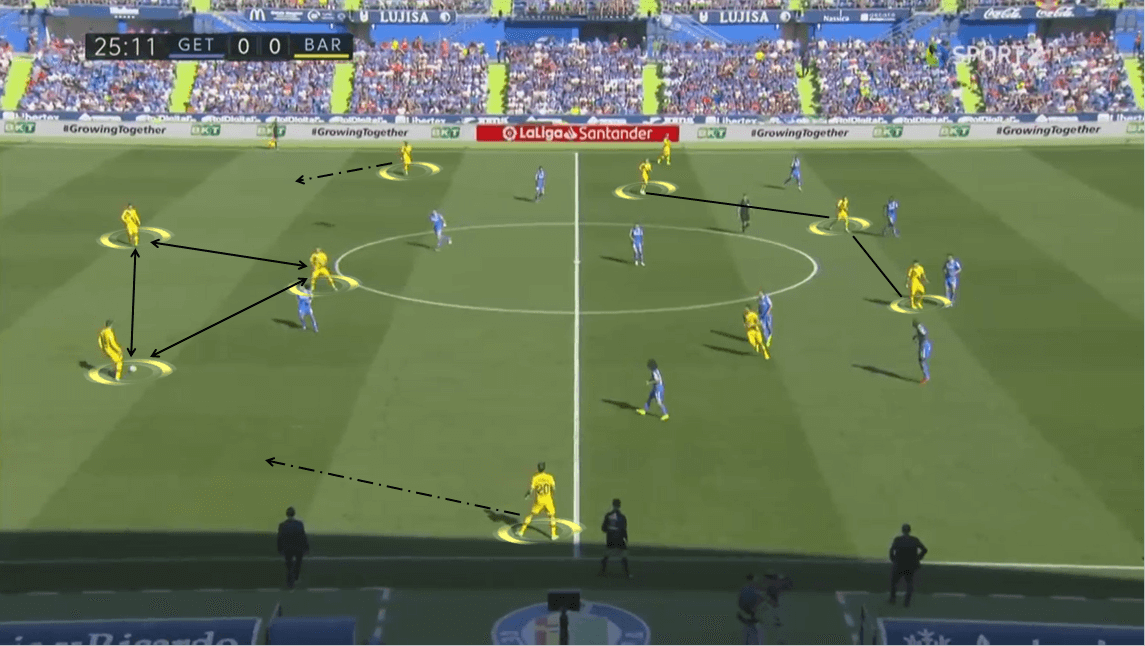
It was a very simple build-up strategy as Barcelona didn’t use any complicated instructions or rely on intelligent movements. It was just the case of countering against the opposition’s tactics and made the most out of their weaknesses. Still, with the talented individuals that they had, the visitors were able to keep more of the ball possession (62%) and execute their plans.
Firstly, straight from the build-up process their shape stretched wide on several occasions and allowed the wing-backs to make overlapping runs out wide. There, either centre-back would find them using a long pass that headed towards their run which capitalised on the fact that Getafé focused on defending the half-spaces and the central area of the pitch.
Being a wing-oriented team with pacey players such as Júnior Firpo and Roberto, this strategy became useful for them. They were able to hit the home side on the break and put the ball carrier into an active state for him to do what he intended.
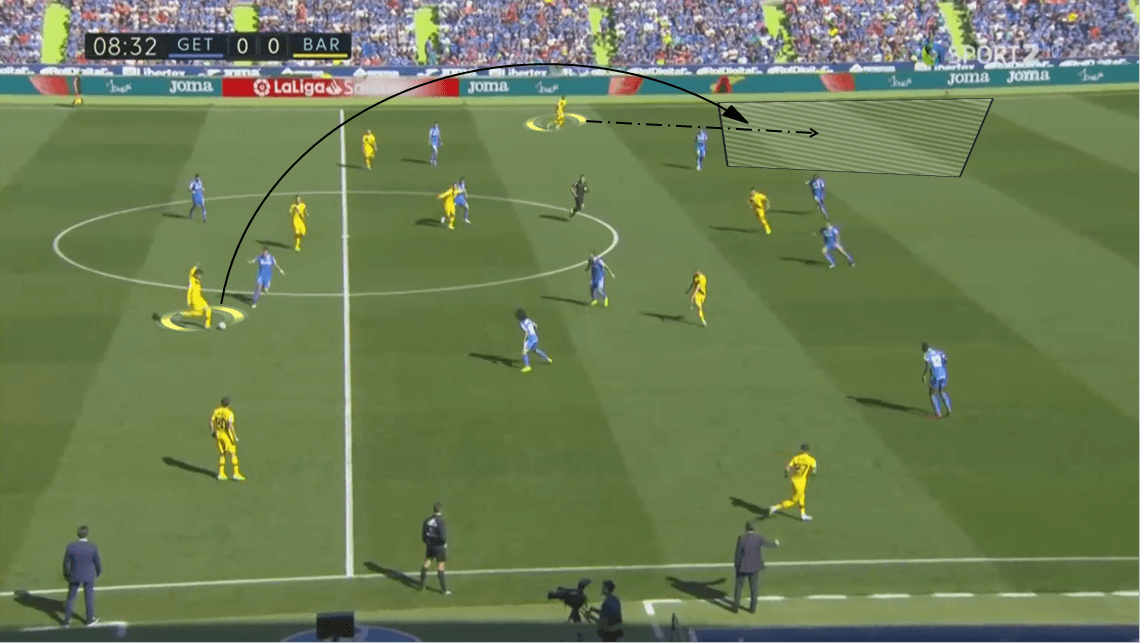
Secondly, as mentioned above, Barcelona were great in capitalising the space that Getafé players left behind. Combined with the fact that they defended narrowly in front of their box, it was an opportunity for wide players to make the most out of that major problem. Firpo’s goal was the perfect example of this and it was demonstrated in the shot below.
It’s quite surprising to see Pérez receive the pass from Roberto in free space and without any significant pressure. After the Barcelona right-back laid the ball off, he dragged along at least three players with him. At the same time, with the Getafé defenders focused on defending zone 14, they opted not to step out from their positions and tackle the ball away from Pérez. He had all the time and space to take a shot, which was denied by Soria with a stunning reflex.
Also notice how Firpo was free enough to move into the 16-yard box. At first, Jason was tasked to follow him and prevented him from making a progressive run. But as he noticed Pérez already taken the shot, the former Levante player slowed his pace down and lost track of Firpo. It allowed the Spanish-Dominican defender to approach the ball and convert the rebound into the second goal of the game.
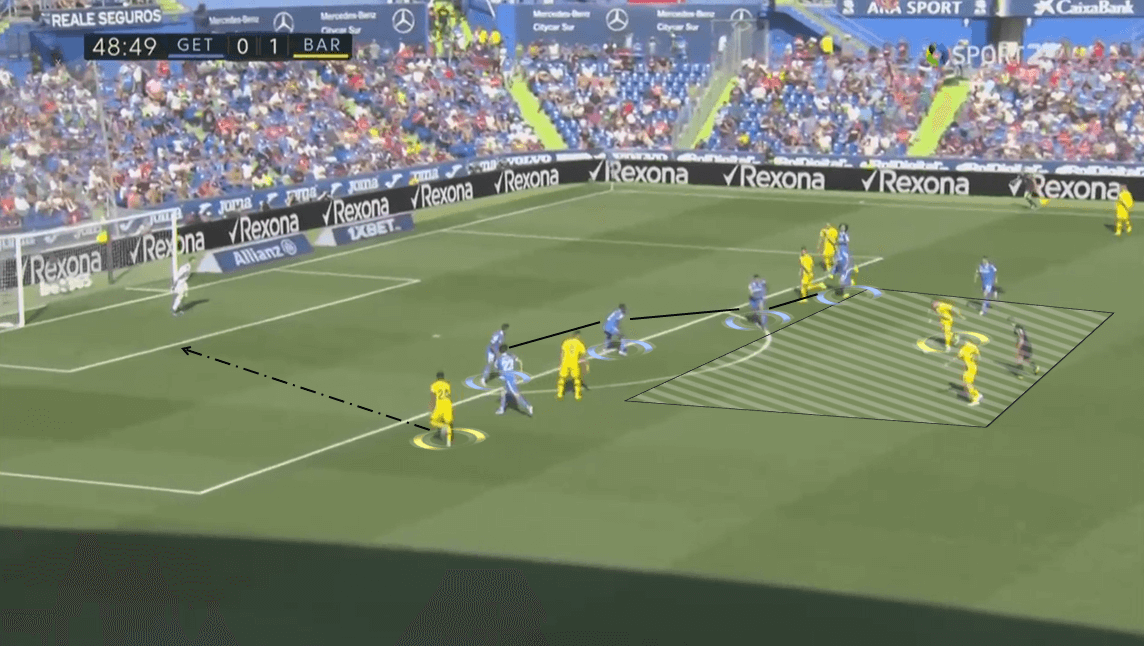
Defensively, Barcelona players would form a 4-5-1 defensive shape that at times, looked like a 4-3-3 depending on how the situation developed. The strikers formed the first line of engagement and their responsibilities were to stretch wide to fill in the half-spaces and disrupt Getafé’s build-up.
Meanwhile, three central midfielders stayed quite compact below three attackers as they aimed to narrow the gap between the defensive line and them. At the same time, they would screen the edge of the final third as the shape retreated back in front of the box. The defensive line was more flexible to deal with Getafé’s attacking threat. As shown below, each of Barcelona’s defenders followed an attacker on the opposite side. They prevented themselves from being pinned down and therefore, created more space for Nemanja Maksimović and Arambarri to move in.
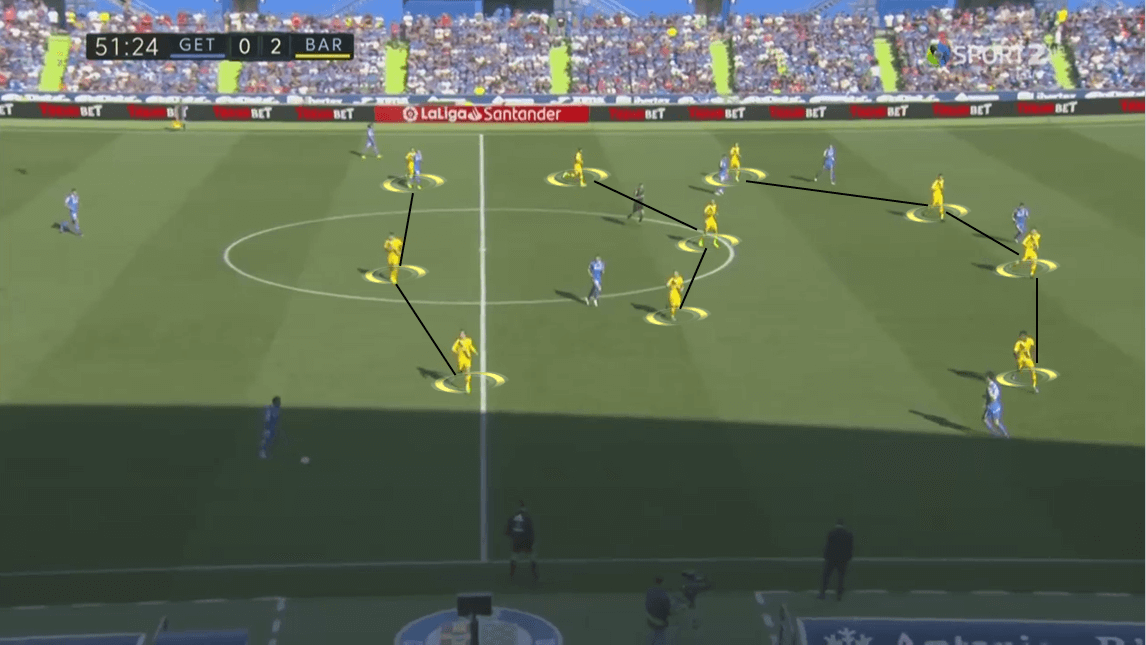
It’s also worth noticing that Frenkie de Jong had quite a significant influence on how Barcelona played in this game. As one of the two central midfielders, he took up a more dynamic role which was linking the team’s play. It was shown clearly on his heatmap below as he spent much of the time playing inside the central area but also drifting wide when needed.
In terms of his stats, he registered a total of forty passes while completing 32 of them. At the same time, he also had two of his three long balls found its final destination(s). In defence, the Dutch wonderkid was involved in six defensive duels and won four of them. Frenkie also made five interceptions and eight recoveries. Decent numbers for a player who is still adapting to a new environment and Frenkie will surely improve these numbers as he progresses throughout the season.
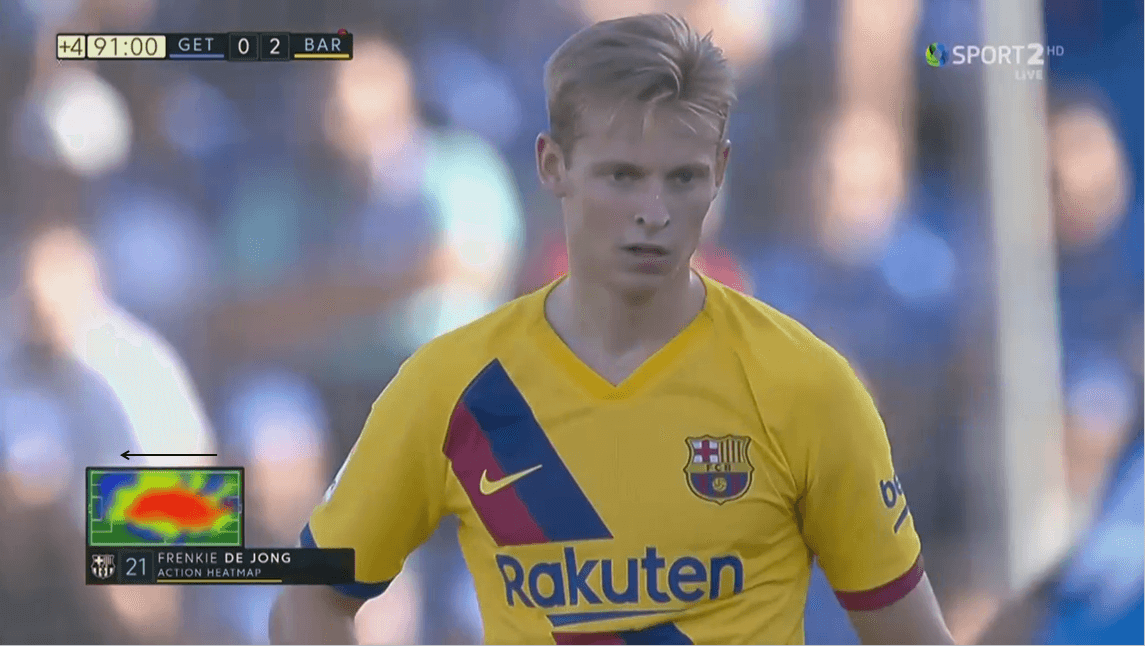
Conclusion
At the end of the day, the team who converted their chances deserved to take three points home, which was the case for Barcelona. They had a good game, keeping things true to what they have done over the seasons, and being sharp in front of goal. It’s no doubt that as the visitors will walk away with three points, they will use this as momentum to push on towards their Champions League match against Inter Milan.
For Getafé, on the other hand, some opinions might suggest that they didn’t deserve to lose this game, while others might think differently. Indeed, there were times that Bordalás’ side matched Barcelona and created a fair few chances towards their goal. But all they needed was luck to turn the chances they had into the back of the net. Nonetheless, they should keep their heads held high as the players continue to prepare for the trip to Russia and face Krasnodar in the Europa League.

If you love tactical analysis, then you’ll love the digital magazines from totalfootballanalysis.com – a guaranteed 100+ pages of pure tactical analysis covering topics from the Premier League, Serie A, La Liga, Bundesliga and many, many more. Buy your copy of the September issue for just ₤4.99 here





Comments